Policy Brief on Illiteracy and Socio-Economic Challenges in India
VerifiedAdded on 2022/08/26
|9
|1746
|9
Report
AI Summary
This policy brief examines the critical issue of illiteracy in India, highlighting its detrimental impact on socio-economic development. It begins by defining the problem, emphasizing the reasons behind the high illiteracy rates, including lack of quality education, female illiteracy, and poverty. The brief then delves into the social policy challenges posed by illiteracy, such as inaccurate census data and the limitations of the 'literate' definition. It underscores the historical context of illiteracy in independent India and its consequences, including slower economic growth and gender inequality. The report also explores the government's role in addressing illiteracy, including the importance of free education, increased educational facilities, and the need to address child labor. Finally, it identifies potential policy options, such as awareness campaigns, incentives, and stricter enforcement of child labor laws, emphasizing the need for a multi-faceted approach to eradicate illiteracy and promote inclusive development. The report also provides references to support the arguments.
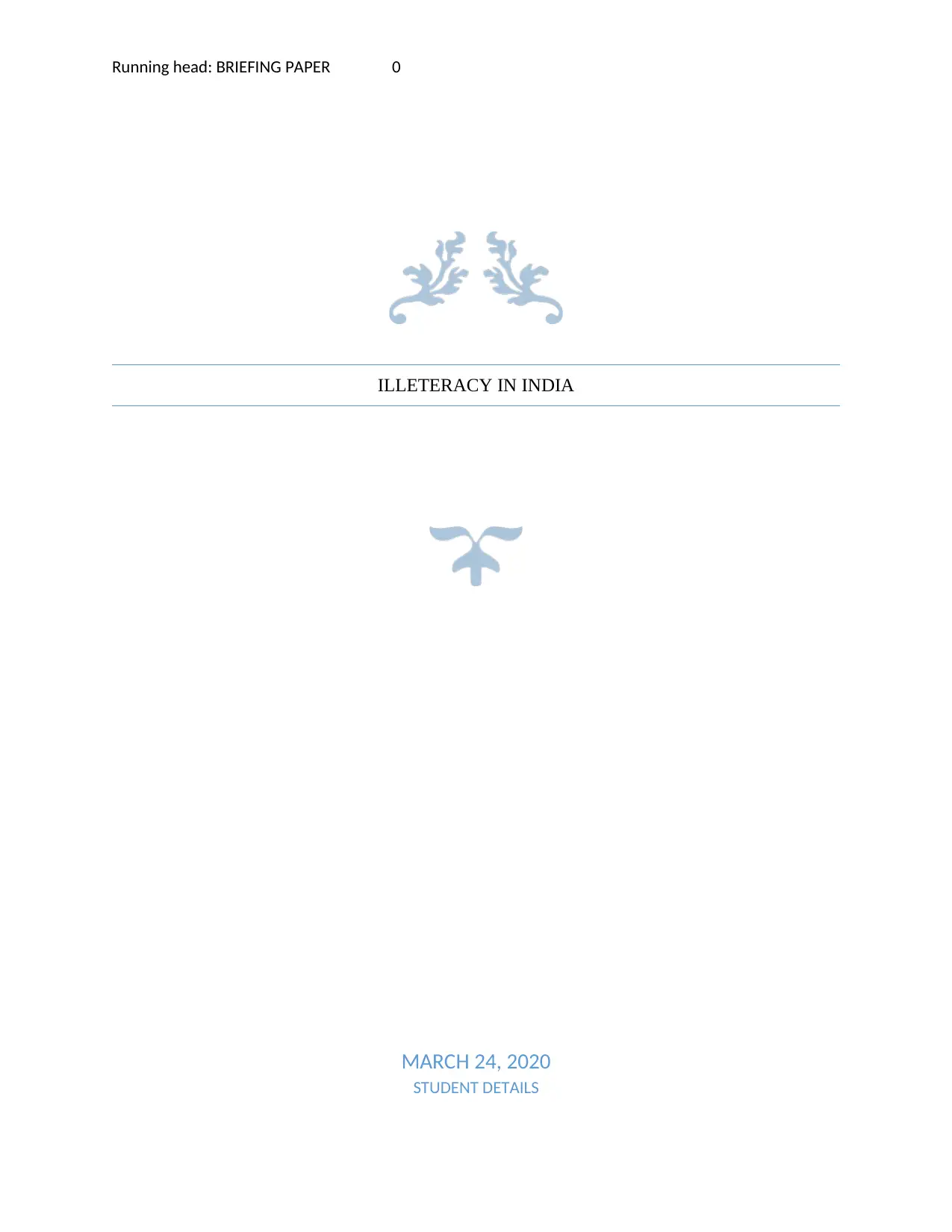
Running head: BRIEFING PAPER 0
ILLETERACY IN INDIA
MARCH 24, 2020
STUDENT DETAILS
ILLETERACY IN INDIA
MARCH 24, 2020
STUDENT DETAILS
Paraphrase This Document
Need a fresh take? Get an instant paraphrase of this document with our AI Paraphraser

BRIEFING PAPER 1
Contents
A clear statement of the purpose of policy brief..............................................................................2
A concise summary of the social policy challenge..........................................................................2
Identification of some available policy options...............................................................................4
Reference list...................................................................................................................................6
Contents
A clear statement of the purpose of policy brief..............................................................................2
A concise summary of the social policy challenge..........................................................................2
Identification of some available policy options...............................................................................4
Reference list...................................................................................................................................6

BRIEFING PAPER 2
A clear statement of the purpose of policy brief
In India, the literacy is essential for the socio-economic development. The illiteracy is biggest
issue in India. India is 2nd largest populated country among all. The rate of illiteracy is higher
there. There are various reasons of illiteracy in India1. These reasons include absence of quality
education, illiteracy amongst females as well as poverty. The main purpose of this policy brief is
to highlight the issue of illiteracy in India. It also discusses the social policy challenges and
available policy options to reduce the problem of illiteracy in India.
A concise summary of the social policy challenge
The accuracy of census data such as rate of literacy in India challenges capability of business to
keep informed the strategic decision. The ‘Literate’ does not certainly mean that the population
can write or even read. This is indirectly understood in India that the person who can do
signature of the name, independent of whether it is readable or comprehensive, would be
1 Shiv Prakash Katiyar. "Illiteracy flagging India." Learning Community: An International Journal of Educational and
Social Development 7, no. 3 (2016): 305.
A clear statement of the purpose of policy brief
In India, the literacy is essential for the socio-economic development. The illiteracy is biggest
issue in India. India is 2nd largest populated country among all. The rate of illiteracy is higher
there. There are various reasons of illiteracy in India1. These reasons include absence of quality
education, illiteracy amongst females as well as poverty. The main purpose of this policy brief is
to highlight the issue of illiteracy in India. It also discusses the social policy challenges and
available policy options to reduce the problem of illiteracy in India.
A concise summary of the social policy challenge
The accuracy of census data such as rate of literacy in India challenges capability of business to
keep informed the strategic decision. The ‘Literate’ does not certainly mean that the population
can write or even read. This is indirectly understood in India that the person who can do
signature of the name, independent of whether it is readable or comprehensive, would be
1 Shiv Prakash Katiyar. "Illiteracy flagging India." Learning Community: An International Journal of Educational and
Social Development 7, no. 3 (2016): 305.
⊘ This is a preview!⊘
Do you want full access?
Subscribe today to unlock all pages.

Trusted by 1+ million students worldwide
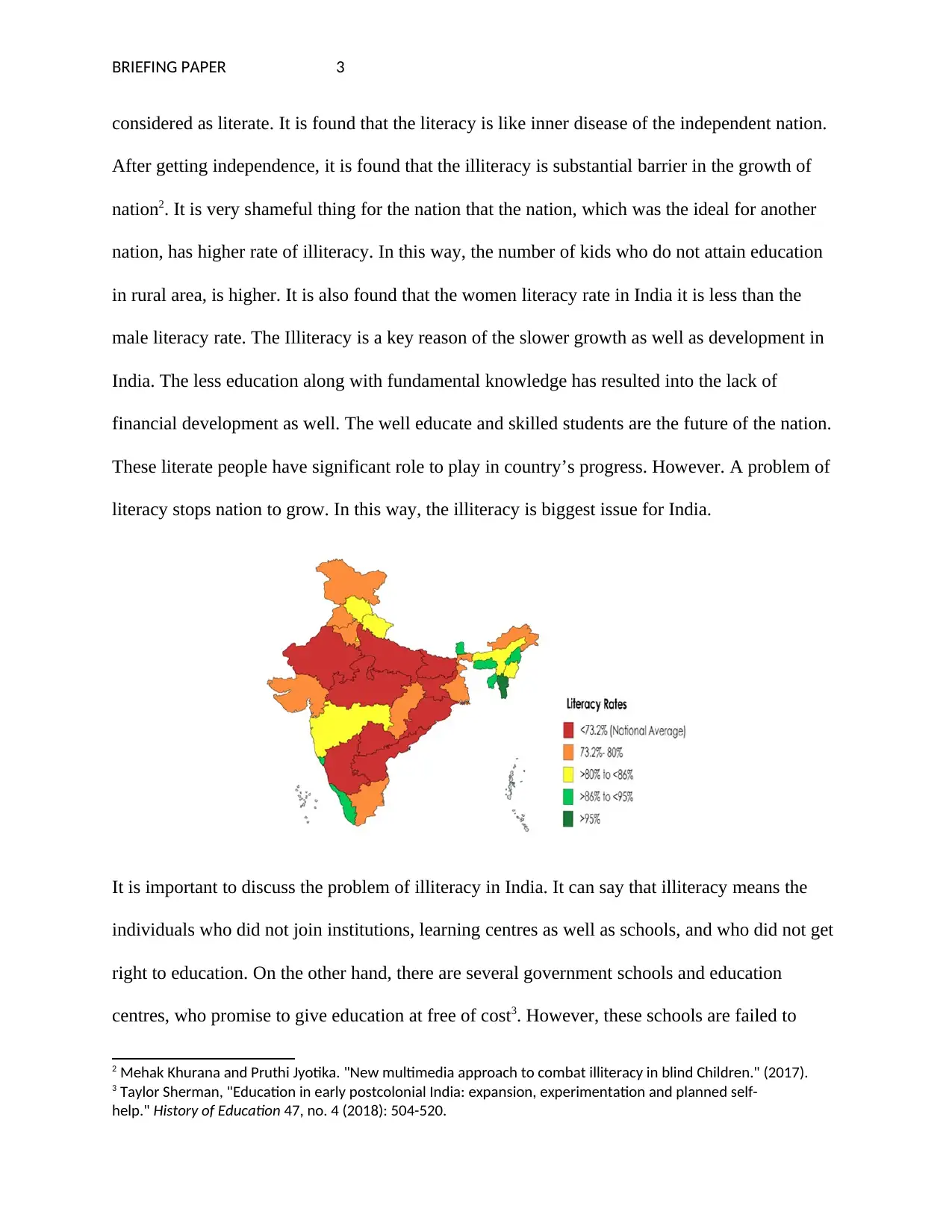
BRIEFING PAPER 3
considered as literate. It is found that the literacy is like inner disease of the independent nation.
After getting independence, it is found that the illiteracy is substantial barrier in the growth of
nation2. It is very shameful thing for the nation that the nation, which was the ideal for another
nation, has higher rate of illiteracy. In this way, the number of kids who do not attain education
in rural area, is higher. It is also found that the women literacy rate in India it is less than the
male literacy rate. The Illiteracy is a key reason of the slower growth as well as development in
India. The less education along with fundamental knowledge has resulted into the lack of
financial development as well. The well educate and skilled students are the future of the nation.
These literate people have significant role to play in country’s progress. However. A problem of
literacy stops nation to grow. In this way, the illiteracy is biggest issue for India.
It is important to discuss the problem of illiteracy in India. It can say that illiteracy means the
individuals who did not join institutions, learning centres as well as schools, and who did not get
right to education. On the other hand, there are several government schools and education
centres, who promise to give education at free of cost3. However, these schools are failed to
2 Mehak Khurana and Pruthi Jyotika. "New multimedia approach to combat illiteracy in blind Children." (2017).
3 Taylor Sherman, "Education in early postcolonial India: expansion, experimentation and planned self-
help." History of Education 47, no. 4 (2018): 504-520.
considered as literate. It is found that the literacy is like inner disease of the independent nation.
After getting independence, it is found that the illiteracy is substantial barrier in the growth of
nation2. It is very shameful thing for the nation that the nation, which was the ideal for another
nation, has higher rate of illiteracy. In this way, the number of kids who do not attain education
in rural area, is higher. It is also found that the women literacy rate in India it is less than the
male literacy rate. The Illiteracy is a key reason of the slower growth as well as development in
India. The less education along with fundamental knowledge has resulted into the lack of
financial development as well. The well educate and skilled students are the future of the nation.
These literate people have significant role to play in country’s progress. However. A problem of
literacy stops nation to grow. In this way, the illiteracy is biggest issue for India.
It is important to discuss the problem of illiteracy in India. It can say that illiteracy means the
individuals who did not join institutions, learning centres as well as schools, and who did not get
right to education. On the other hand, there are several government schools and education
centres, who promise to give education at free of cost3. However, these schools are failed to
2 Mehak Khurana and Pruthi Jyotika. "New multimedia approach to combat illiteracy in blind Children." (2017).
3 Taylor Sherman, "Education in early postcolonial India: expansion, experimentation and planned self-
help." History of Education 47, no. 4 (2018): 504-520.
Paraphrase This Document
Need a fresh take? Get an instant paraphrase of this document with our AI Paraphraser
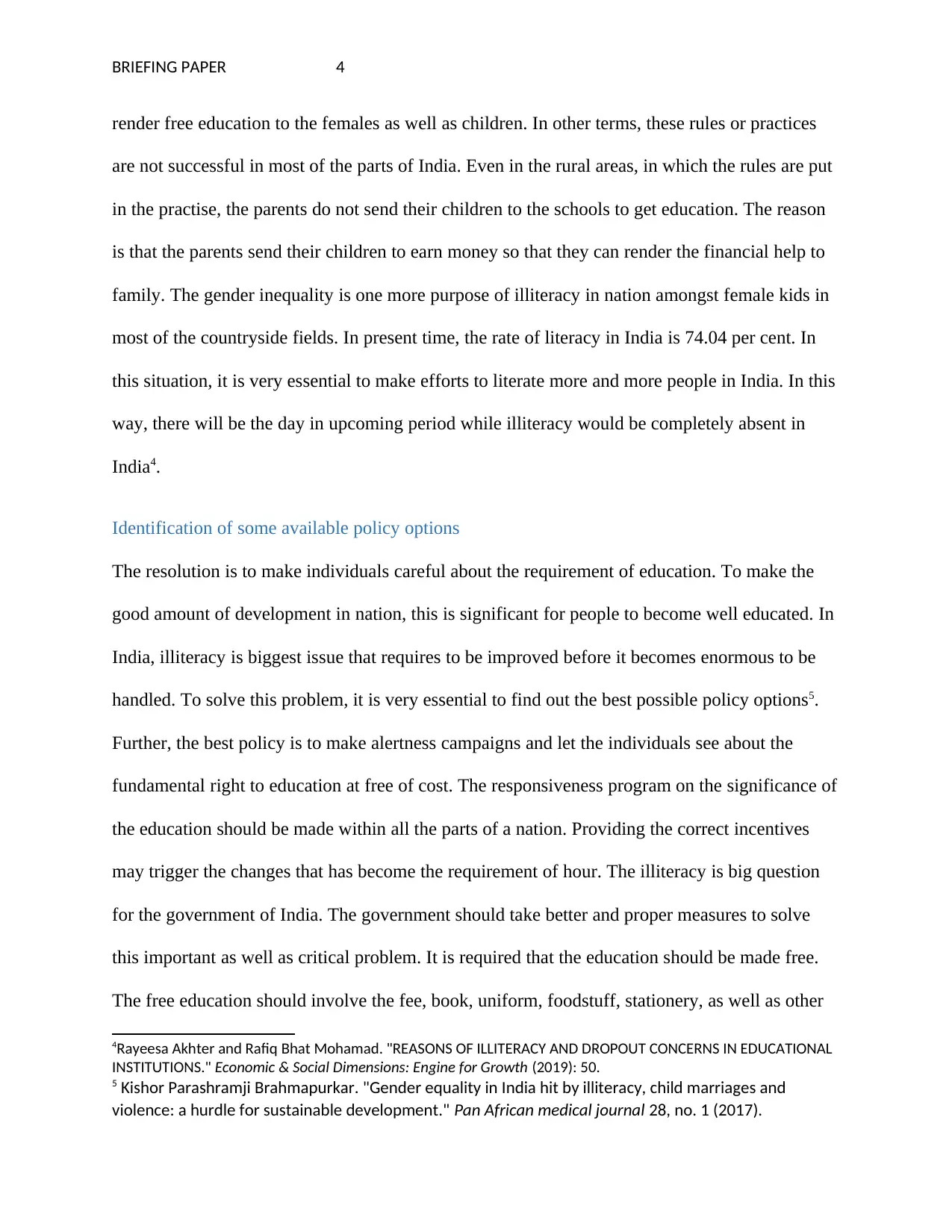
BRIEFING PAPER 4
render free education to the females as well as children. In other terms, these rules or practices
are not successful in most of the parts of India. Even in the rural areas, in which the rules are put
in the practise, the parents do not send their children to the schools to get education. The reason
is that the parents send their children to earn money so that they can render the financial help to
family. The gender inequality is one more purpose of illiteracy in nation amongst female kids in
most of the countryside fields. In present time, the rate of literacy in India is 74.04 per cent. In
this situation, it is very essential to make efforts to literate more and more people in India. In this
way, there will be the day in upcoming period while illiteracy would be completely absent in
India4.
Identification of some available policy options
The resolution is to make individuals careful about the requirement of education. To make the
good amount of development in nation, this is significant for people to become well educated. In
India, illiteracy is biggest issue that requires to be improved before it becomes enormous to be
handled. To solve this problem, it is very essential to find out the best possible policy options5.
Further, the best policy is to make alertness campaigns and let the individuals see about the
fundamental right to education at free of cost. The responsiveness program on the significance of
the education should be made within all the parts of a nation. Providing the correct incentives
may trigger the changes that has become the requirement of hour. The illiteracy is big question
for the government of India. The government should take better and proper measures to solve
this important as well as critical problem. It is required that the education should be made free.
The free education should involve the fee, book, uniform, foodstuff, stationery, as well as other
4Rayeesa Akhter and Rafiq Bhat Mohamad. "REASONS OF ILLITERACY AND DROPOUT CONCERNS IN EDUCATIONAL
INSTITUTIONS." Economic & Social Dimensions: Engine for Growth (2019): 50.
5 Kishor Parashramji Brahmapurkar. "Gender equality in India hit by illiteracy, child marriages and
violence: a hurdle for sustainable development." Pan African medical journal 28, no. 1 (2017).
render free education to the females as well as children. In other terms, these rules or practices
are not successful in most of the parts of India. Even in the rural areas, in which the rules are put
in the practise, the parents do not send their children to the schools to get education. The reason
is that the parents send their children to earn money so that they can render the financial help to
family. The gender inequality is one more purpose of illiteracy in nation amongst female kids in
most of the countryside fields. In present time, the rate of literacy in India is 74.04 per cent. In
this situation, it is very essential to make efforts to literate more and more people in India. In this
way, there will be the day in upcoming period while illiteracy would be completely absent in
India4.
Identification of some available policy options
The resolution is to make individuals careful about the requirement of education. To make the
good amount of development in nation, this is significant for people to become well educated. In
India, illiteracy is biggest issue that requires to be improved before it becomes enormous to be
handled. To solve this problem, it is very essential to find out the best possible policy options5.
Further, the best policy is to make alertness campaigns and let the individuals see about the
fundamental right to education at free of cost. The responsiveness program on the significance of
the education should be made within all the parts of a nation. Providing the correct incentives
may trigger the changes that has become the requirement of hour. The illiteracy is big question
for the government of India. The government should take better and proper measures to solve
this important as well as critical problem. It is required that the education should be made free.
The free education should involve the fee, book, uniform, foodstuff, stationery, as well as other
4Rayeesa Akhter and Rafiq Bhat Mohamad. "REASONS OF ILLITERACY AND DROPOUT CONCERNS IN EDUCATIONAL
INSTITUTIONS." Economic & Social Dimensions: Engine for Growth (2019): 50.
5 Kishor Parashramji Brahmapurkar. "Gender equality in India hit by illiteracy, child marriages and
violence: a hurdle for sustainable development." Pan African medical journal 28, no. 1 (2017).

BRIEFING PAPER 5
things required by the children. The government should ensure that the government schools are
providing the free education including books, food, and material on regular basis6.
In addition, the Indian government should make more leaning centres as well as schools
everywhere in India. Moreover, the state government as well as central government should have
sufficient budgets for overcoming the issue of illiteracy in country. The Indian government
should make more and more efforts to bring all the children to the schools or learning centres7.
The government should try to convince the parents to send their children to schools8. In actual
fact, the government should also restrict the children labour to solve this critical problem. The
government should take strict actions towards the people who employ children at the work.
Additionally, the non-profit organisations should also take necessary actions to provide
necessary facilities of the education to the poor children. It is very essential to motivate the
6 Kshama Pandey. "Mobile Education Mitigating the Heavy Magnitude of Illiteracy in India." In Human-Computer
Interaction: Concepts, Methodologies, Tools, and Applications, pp. 35-61. IGI Global, 2016.
7 Rupali Patil, and Jadhav Omprakash. "A Statistical Study on Educational Development Index for Literacy
Parameters of India." Economic Affairs 62, no. 3 (2017): 537-542.
8 Papita Dutta. "Deprivation of Women in Northeast India: An Exploratory Study." In Inequality, Poverty
and Development in India, pp. 223-236. Springer, Singapore, 2017.
things required by the children. The government should ensure that the government schools are
providing the free education including books, food, and material on regular basis6.
In addition, the Indian government should make more leaning centres as well as schools
everywhere in India. Moreover, the state government as well as central government should have
sufficient budgets for overcoming the issue of illiteracy in country. The Indian government
should make more and more efforts to bring all the children to the schools or learning centres7.
The government should try to convince the parents to send their children to schools8. In actual
fact, the government should also restrict the children labour to solve this critical problem. The
government should take strict actions towards the people who employ children at the work.
Additionally, the non-profit organisations should also take necessary actions to provide
necessary facilities of the education to the poor children. It is very essential to motivate the
6 Kshama Pandey. "Mobile Education Mitigating the Heavy Magnitude of Illiteracy in India." In Human-Computer
Interaction: Concepts, Methodologies, Tools, and Applications, pp. 35-61. IGI Global, 2016.
7 Rupali Patil, and Jadhav Omprakash. "A Statistical Study on Educational Development Index for Literacy
Parameters of India." Economic Affairs 62, no. 3 (2017): 537-542.
8 Papita Dutta. "Deprivation of Women in Northeast India: An Exploratory Study." In Inequality, Poverty
and Development in India, pp. 223-236. Springer, Singapore, 2017.
⊘ This is a preview!⊘
Do you want full access?
Subscribe today to unlock all pages.

Trusted by 1+ million students worldwide
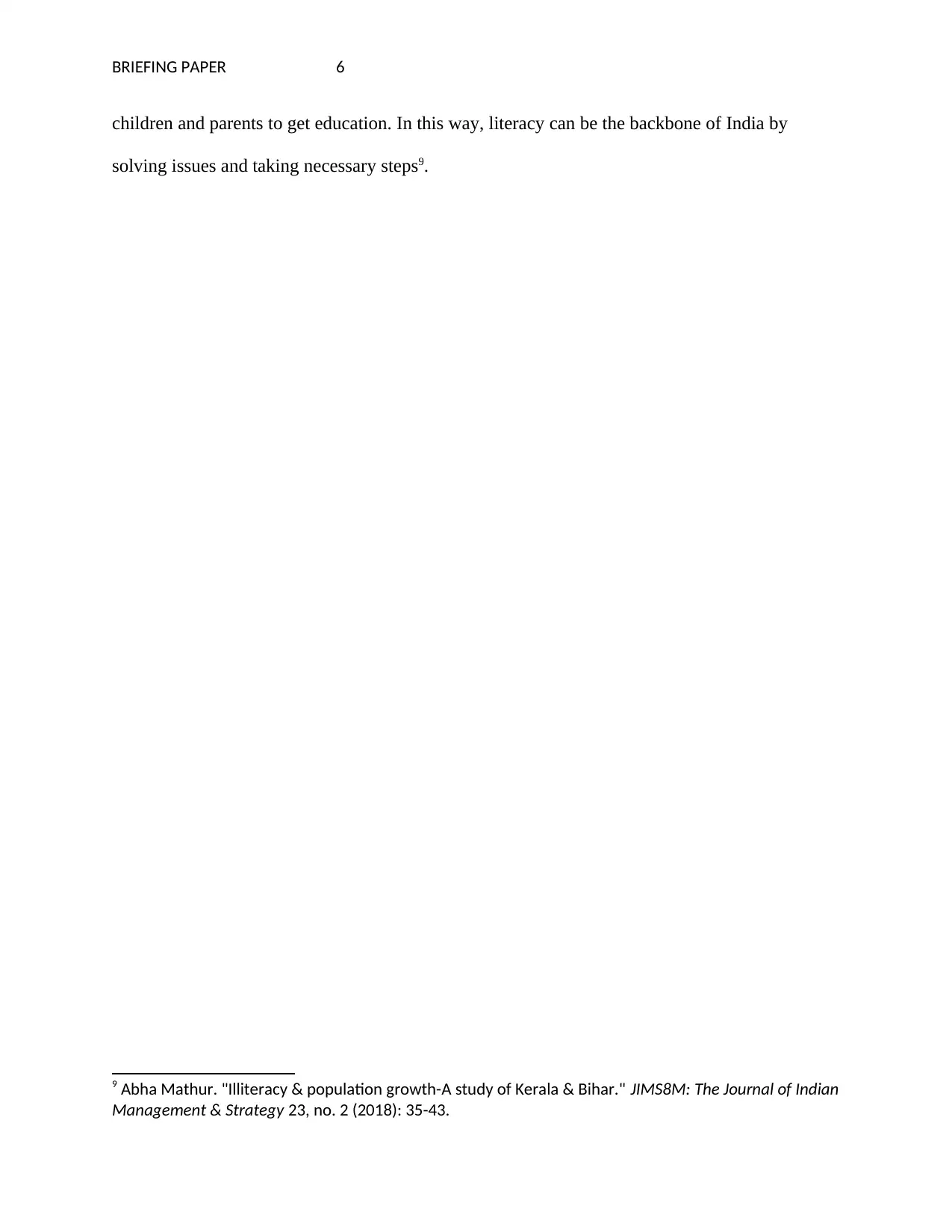
BRIEFING PAPER 6
children and parents to get education. In this way, literacy can be the backbone of India by
solving issues and taking necessary steps9.
9 Abha Mathur. "Illiteracy & population growth-A study of Kerala & Bihar." JIMS8M: The Journal of Indian
Management & Strategy 23, no. 2 (2018): 35-43.
children and parents to get education. In this way, literacy can be the backbone of India by
solving issues and taking necessary steps9.
9 Abha Mathur. "Illiteracy & population growth-A study of Kerala & Bihar." JIMS8M: The Journal of Indian
Management & Strategy 23, no. 2 (2018): 35-43.
Paraphrase This Document
Need a fresh take? Get an instant paraphrase of this document with our AI Paraphraser
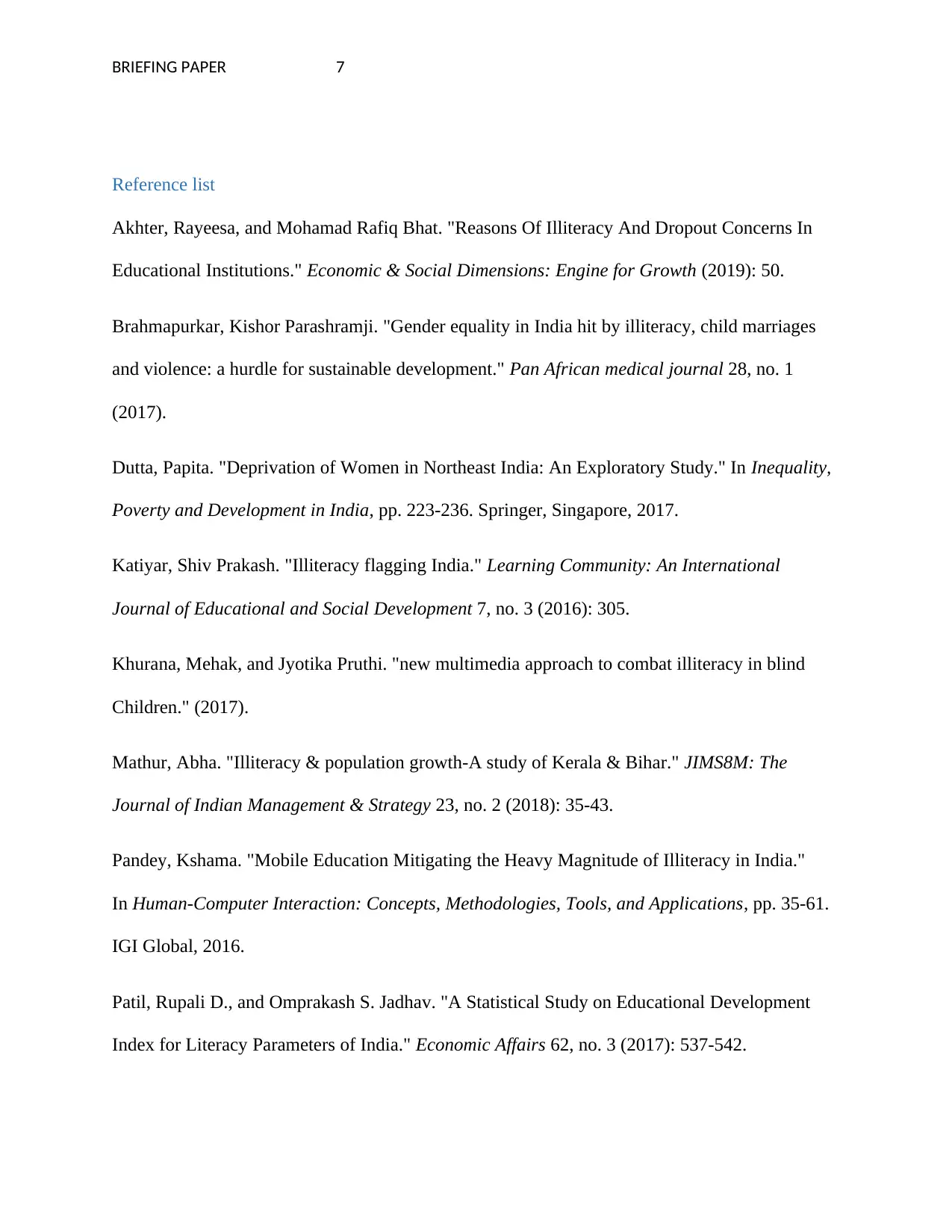
BRIEFING PAPER 7
Reference list
Akhter, Rayeesa, and Mohamad Rafiq Bhat. "Reasons Of Illiteracy And Dropout Concerns In
Educational Institutions." Economic & Social Dimensions: Engine for Growth (2019): 50.
Brahmapurkar, Kishor Parashramji. "Gender equality in India hit by illiteracy, child marriages
and violence: a hurdle for sustainable development." Pan African medical journal 28, no. 1
(2017).
Dutta, Papita. "Deprivation of Women in Northeast India: An Exploratory Study." In Inequality,
Poverty and Development in India, pp. 223-236. Springer, Singapore, 2017.
Katiyar, Shiv Prakash. "Illiteracy flagging India." Learning Community: An International
Journal of Educational and Social Development 7, no. 3 (2016): 305.
Khurana, Mehak, and Jyotika Pruthi. "new multimedia approach to combat illiteracy in blind
Children." (2017).
Mathur, Abha. "Illiteracy & population growth-A study of Kerala & Bihar." JIMS8M: The
Journal of Indian Management & Strategy 23, no. 2 (2018): 35-43.
Pandey, Kshama. "Mobile Education Mitigating the Heavy Magnitude of Illiteracy in India."
In Human-Computer Interaction: Concepts, Methodologies, Tools, and Applications, pp. 35-61.
IGI Global, 2016.
Patil, Rupali D., and Omprakash S. Jadhav. "A Statistical Study on Educational Development
Index for Literacy Parameters of India." Economic Affairs 62, no. 3 (2017): 537-542.
Reference list
Akhter, Rayeesa, and Mohamad Rafiq Bhat. "Reasons Of Illiteracy And Dropout Concerns In
Educational Institutions." Economic & Social Dimensions: Engine for Growth (2019): 50.
Brahmapurkar, Kishor Parashramji. "Gender equality in India hit by illiteracy, child marriages
and violence: a hurdle for sustainable development." Pan African medical journal 28, no. 1
(2017).
Dutta, Papita. "Deprivation of Women in Northeast India: An Exploratory Study." In Inequality,
Poverty and Development in India, pp. 223-236. Springer, Singapore, 2017.
Katiyar, Shiv Prakash. "Illiteracy flagging India." Learning Community: An International
Journal of Educational and Social Development 7, no. 3 (2016): 305.
Khurana, Mehak, and Jyotika Pruthi. "new multimedia approach to combat illiteracy in blind
Children." (2017).
Mathur, Abha. "Illiteracy & population growth-A study of Kerala & Bihar." JIMS8M: The
Journal of Indian Management & Strategy 23, no. 2 (2018): 35-43.
Pandey, Kshama. "Mobile Education Mitigating the Heavy Magnitude of Illiteracy in India."
In Human-Computer Interaction: Concepts, Methodologies, Tools, and Applications, pp. 35-61.
IGI Global, 2016.
Patil, Rupali D., and Omprakash S. Jadhav. "A Statistical Study on Educational Development
Index for Literacy Parameters of India." Economic Affairs 62, no. 3 (2017): 537-542.

BRIEFING PAPER 8
Sherman, Taylor C. "Education in early postcolonial India: expansion, experimentation and
planned self-help." History of Education 47, no. 4 (2018): 504-520
Sherman, Taylor C. "Education in early postcolonial India: expansion, experimentation and
planned self-help." History of Education 47, no. 4 (2018): 504-520
⊘ This is a preview!⊘
Do you want full access?
Subscribe today to unlock all pages.

Trusted by 1+ million students worldwide
1 out of 9
Related Documents
Your All-in-One AI-Powered Toolkit for Academic Success.
+13062052269
info@desklib.com
Available 24*7 on WhatsApp / Email
![[object Object]](/_next/static/media/star-bottom.7253800d.svg)
Unlock your academic potential
Copyright © 2020–2025 A2Z Services. All Rights Reserved. Developed and managed by ZUCOL.





